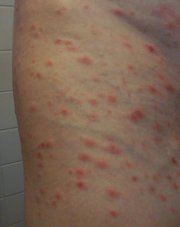Pityriasis lichenoides et varioliformis acuta
Pityriasis Lichenoides et Varioliformis Acuta, or Mucha Habermann's Disease, short form PLEVA, is a disease of the immune system. It is the more severe version of Pityriasis lichenoides chronica. The disease is characterized by rashes and small lesions on the skin. It is not contagious and currently there is no cure for the disease, although the lesions can be treated with ultraviolet therapy as well as topical steroides and antibiotics. The disease is most common in males and usually accures in childhood, although it has been seen in every race and age group. It is possible for the disease to go into remission for short periods of time or forever. more...
It is commonly misdiagnosed, the most common way to diagnose is by biopsy. This disease has not been known to be life threatening. There is no known cause of this disease, however many links from viruses, vaccines, and other illnesses have been made. The easiest way to understand this disease is to think of it like this. Everyone has T cells that fight disease, In a person with PLEVA the T cells get mixed up and decide to form in the skin causing the lesions. It is unknown why this happens.
Read more at Wikipedia.org



